Today a new film book will be presented, 'Haarlem filmstad' (Haarlem film city), edited by Harry Hosman and Arie Vestering. 'Haarlem Film city' describes the cinema life and the well-known and lesser-known studios, filmmakers and stars from the Dutch city. During the 1910s and 1920s, Haarlem even seemed to be the centre of the Dutch film world. Cameramen, actors and set builders walked back and forth in the Filmfabriek Hollandia at the Spaarne river, where dozens of silent films were created. Haarlem-based actresses like Annie Bos achieved star-status. For this new book, I wrote a chapter on film poster designer Frans Bosen, who worked and lived in Haarlem, and designed dozens of colourful film posters during the 1920s. EFSP joins the festivities around the book presentation with a post on the work of Frans Bosen, but we start with a very rare card with Annie Bos which we found just a few weeks ago.
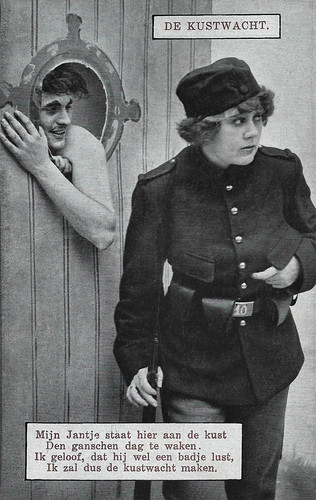
Dutch postcard by E & B. Photo: Annie Bos in Toffe jongens onder de mobilisatie (deel 1)/Cool boys under the mobilisation (part 1) (Jan van Dommelen, 1914). Translation caption: The coast guard, My Johnny is here all day on the coast watching, I think he likes a bath, so I'll be the coast guard.
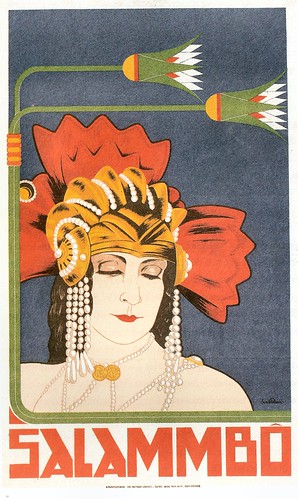
Dutch poster by Frans Bosen for Salammbo (Pierre Maradon, 1924) with Jeanne de Balzac.
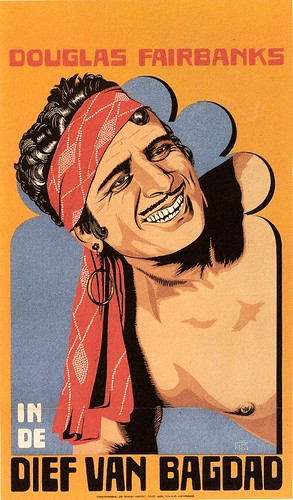
Dutch poster by Frans Bosen for The Thief of Bagdad (Raoul Walsh, 1924) starring Douglas Fairbanks.
Douglas Fairbanks Sr. (1883-1939) was the elegant, dashing, and athletic star of several classic swashbuckling films of the silent era. He produced and starred in ever more elaborate, impressive costume films, such as The Three Musketeers (Fred Niblo, 1921), Robin Hood (Allan Dwan, 1922), The Thief of Bagdad (Raoul Walsh, 1924), The Black Pirate (Albert Parker, 1926, the first full-length Technicolor film), and The Gaucho (F. Richard Jones, 1927) with Lupe Velez. With his marriage to Mary Pickford in 1920, the couple became Hollywood royalty and Fairbanks was referred to as ‘The King of Hollywood'.
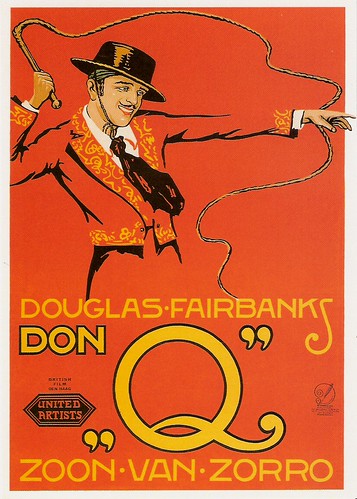
Dutch poster by Frans Bosen for Don Q Son of Zorro (Donald Crisp, 1925) starring Douglas Fairbanks.
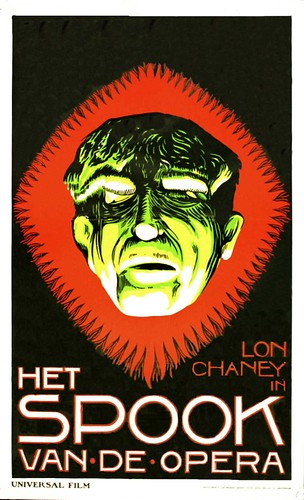
Dutch poster by Frans Bosen for The Phantom of the Opera (Rupert Julian, 1925) with Lon Chaney.
Lon Chaney (1883-1930) was one of the most versatile and powerful actors of early cinema. Between 1912 and 1930 he played more the 150 widely diverse roles. He is renowned for his characterisations of tortured, often grotesque and afflicted characters, and his groundbreaking artistry with makeup in such silent horror films as The Hunchback of Notre Dame (Wallace Worsley, (1923), He Who Gets Slapped (Victor Sjöström, 1924) and The Phantom of the Opera (Rupert Julian, 1925).
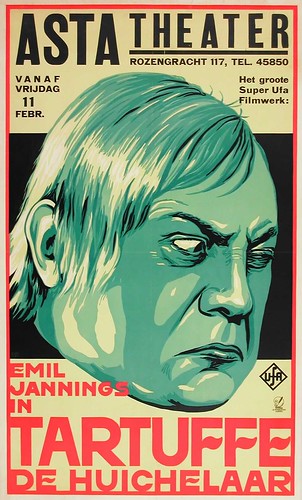
Dutch poster by Frans Bosen for Tartüff/Tartuffe (F.W. Murnau, 1925) starring Emil Jannings.
If Weimar cinema had one film star, then it was Emil Jannings (1884-1950) for sure. Jannings managed to get away from his famous historical characters in such films as Anna Boleyn (Ernst Lubitsch, 1920) and Quo Vadis (Georg Jacoby, Gabriellino D'Annunzio, 1925) with two major films. In Friedrich Wilhelm Murnau's Der letzte Mann/The Last Laugh (1924) he was a proud hotel doorman who loses his self-esteem and the esteem of others when he is reduced to a toilet man, working in the basement of the hotel. In Varieté/Variety (Ewald André Dupont, 1925), he was the strong acrobat, who killed his rival out of jealousy. Jannings magnificently expressed the fears and doubts of proud and big-hearted men, who are cheated by their surroundings. Murnau directed him in two more silent classics Tartüff/Tartuffe (Friedrich Wilhelm Murnau, 1925) with Lil Dagover, and Faust (Friedrich Wilhelm Murnau, 1926) as Mephisto opposite Gösta Ekman as Faust.
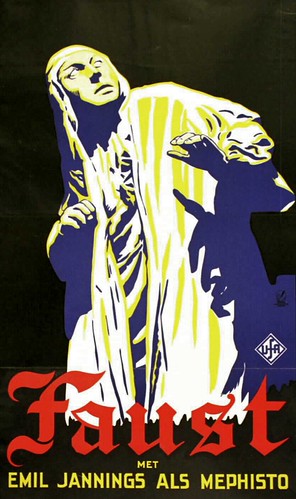
Dutch poster by Frans Bosen for Faust (F.W. Murnau, 1926) starring Emil Jannings.
As a designer of film posters, Bosen was a pioneer: he was one of the first Dutch designers to use film images. Before 1920, mainly 'letter posters' were made in the Netherlands: cinema advertisements with text only, on which a number of films were announced simultaneously. Another habit was to take over the placards from abroad with the films and stick the Dutch title on them. Frans Bosen, on the other hand, designed film posters with original images that stood out with their bright colors and short, powerful texts.
Frans Bosen (1891-1949) made dozens of film posters. The circumstances for these assignments were not comfortable: there was little time and money for it and he had to base his designs on a press photo of the film.
What is striking about his posters is that there is hardly any text on it. Modern film posters mention the credits of the actors, the producers, the director, the screenwriters, the composer, etc. In addition to the film title, Bosen sometimes only gave the name of the protagonist.
He designed the letters himself. Many posters also feature the logo of publisher De Brakke Grond, which was designed by him. The logo even contains his signature, on which he made small variations over the years. The result is often a calm, clear image.
The Bosen posters give a colorful insight into what was seen in Dutch cinemas in the 1920s. There are Hollywood classics among them, including the horror film The Phantom of the Opera (Rupert Julian, 1925) and films with action hero Douglas Fairbanks, for example The Thief of Bagdad (Raoul Walsh, 1924). But he also made many posters for European films, such as the religious film La Vie merveilleuse de Bernadette/The wonderful life of Bernadette (George Pallu, 1929).
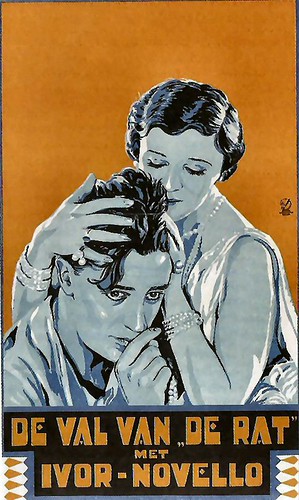
Dutch poster by Frans Bosen for The Triumph of the Rat (Graham Cutts, 1926) with Ivor Novello.
Gorgeous matinee idol Ivor Novello (1893-1951) was one of the multi-talents of the British stage and cinema during the first half of the 20th century. On stage, the 'British Sex God in tight pants' produced and composed a string of hit musicals, starring himself. The 'Valentino from The Valleys' also appeared in the classic Hitchcock thriller The Lodger (1927) and other successful silent and early sound films in France, Great-Britain and Hollywood.
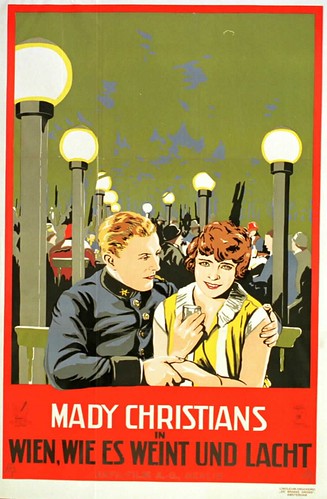
Dutch poster by Frans Bosen for Wien, wie es weint und lacht/Vienna, how it cries and laughs (Rudolf Walther-Fein, Rudolf Dworsky, 1926) with Mady Christians.
Austrian-born stage actress Mady Christians (1892-1951) was a star of the German silent cinema and appeared in Austrian, French, British and Hollywood films too.

Dutch poster by Frans Bosen for Die geschiedene Frau/The Divorcée (Victor Janson, Rudolf Dworsky, 1926) with Mady Christians.
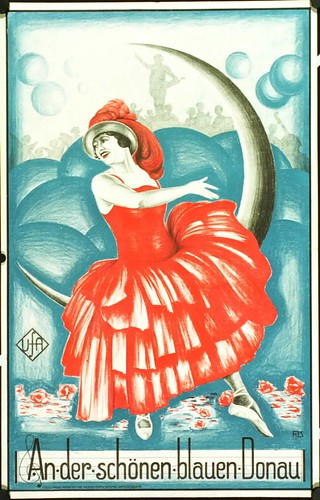
Dutch poster by Frans Bosen for An der Schönen blauen Donau/The Beautiful Blue Danube (Frederic Zelnik, 1926) with Lya Mara.
Lya Mara (1897-1960?) was one of the biggest stars of the German silent cinema. Some immensely successful silent operettas presented her as the perfect Viennese Girl. Hundreds of postcards and trading cards cemented her stardom, which was even the subject of a novel, published in 100 episodes between 1927 and 1928. Her career virtually ended after the arrival of sound film.
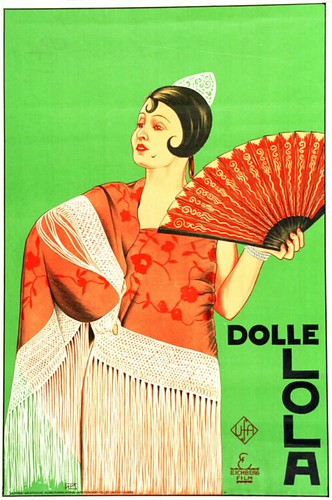
Dutch poster by Frans Bosen for Die tolle Lola/Fabulous Lola (Richard Eichberg, 1927) with Lilian Harvey.
Ufa's biggest star of the 1930s was British born German actress and singer Lilian Harvey (1906-1968). With Willy Fritsch she formed the 'Dream Team of the European Cinema'. In 1924, Harvey made her film debut as the young Jewish girl Ruth in the silent film Der Fluch/The Curse (Robert Land, 1925). Director-producer Richard Eichberg signed her on, and under his direction she played her first leading roles in Leidenschaft/Passion (Richard Eichberg, 1925) with Otto Gebühr, Liebe und Trompetenblasen/Love and Trumpet Blows (Richard Eichberg, 1925) opposite Harry Liedtke, Die keusche Susanne/The Innocent Susanne (Richard Eichberg, 1926) for the first time with Willy Fritsch, and Die tolle Lola/Fabulous Lola (Richard Eichberg, 1927).
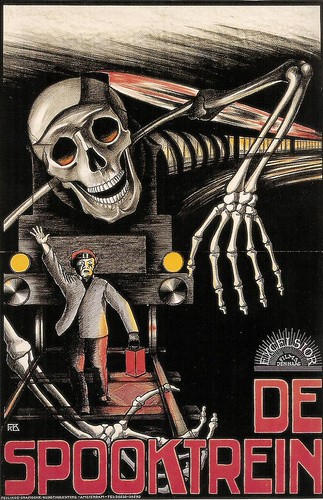
Dutch poster by Frans Bosen for The Ghost Train (Geza von Bolvary, 1927).
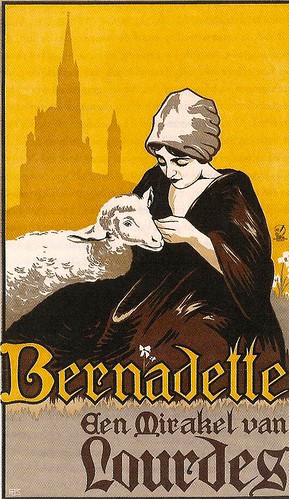
Dutch poster by Frans Bosen for La Vie merveilleuse de Bernadette/The wonderful life of Bernadette (George Pallu, 1929) with Alexandra.
A silent film reconstruction of Bernadette Soubirous's life (1844-1879), a 14-year-old girl that catholics believe had eighteen visions of Mary, the Mother of Jesus, in a grotto near Lourdes, France. The place became a peregrination centre since then.
For more information in Dutch on 'Haarlem Filmstad' see Haarlemfilmstad.nl

Dutch postcard by E & B. Photo: Annie Bos in Toffe jongens onder de mobilisatie (deel 1)/Cool boys under the mobilisation (part 1) (Jan van Dommelen, 1914). Translation caption: The coast guard, My Johnny is here all day on the coast watching, I think he likes a bath, so I'll be the coast guard.

Dutch poster by Frans Bosen for Salammbo (Pierre Maradon, 1924) with Jeanne de Balzac.

Dutch poster by Frans Bosen for The Thief of Bagdad (Raoul Walsh, 1924) starring Douglas Fairbanks.
Douglas Fairbanks Sr. (1883-1939) was the elegant, dashing, and athletic star of several classic swashbuckling films of the silent era. He produced and starred in ever more elaborate, impressive costume films, such as The Three Musketeers (Fred Niblo, 1921), Robin Hood (Allan Dwan, 1922), The Thief of Bagdad (Raoul Walsh, 1924), The Black Pirate (Albert Parker, 1926, the first full-length Technicolor film), and The Gaucho (F. Richard Jones, 1927) with Lupe Velez. With his marriage to Mary Pickford in 1920, the couple became Hollywood royalty and Fairbanks was referred to as ‘The King of Hollywood'.

Dutch poster by Frans Bosen for Don Q Son of Zorro (Donald Crisp, 1925) starring Douglas Fairbanks.

Dutch poster by Frans Bosen for The Phantom of the Opera (Rupert Julian, 1925) with Lon Chaney.
Lon Chaney (1883-1930) was one of the most versatile and powerful actors of early cinema. Between 1912 and 1930 he played more the 150 widely diverse roles. He is renowned for his characterisations of tortured, often grotesque and afflicted characters, and his groundbreaking artistry with makeup in such silent horror films as The Hunchback of Notre Dame (Wallace Worsley, (1923), He Who Gets Slapped (Victor Sjöström, 1924) and The Phantom of the Opera (Rupert Julian, 1925).

Dutch poster by Frans Bosen for Tartüff/Tartuffe (F.W. Murnau, 1925) starring Emil Jannings.
If Weimar cinema had one film star, then it was Emil Jannings (1884-1950) for sure. Jannings managed to get away from his famous historical characters in such films as Anna Boleyn (Ernst Lubitsch, 1920) and Quo Vadis (Georg Jacoby, Gabriellino D'Annunzio, 1925) with two major films. In Friedrich Wilhelm Murnau's Der letzte Mann/The Last Laugh (1924) he was a proud hotel doorman who loses his self-esteem and the esteem of others when he is reduced to a toilet man, working in the basement of the hotel. In Varieté/Variety (Ewald André Dupont, 1925), he was the strong acrobat, who killed his rival out of jealousy. Jannings magnificently expressed the fears and doubts of proud and big-hearted men, who are cheated by their surroundings. Murnau directed him in two more silent classics Tartüff/Tartuffe (Friedrich Wilhelm Murnau, 1925) with Lil Dagover, and Faust (Friedrich Wilhelm Murnau, 1926) as Mephisto opposite Gösta Ekman as Faust.

Dutch poster by Frans Bosen for Faust (F.W. Murnau, 1926) starring Emil Jannings.
Frans Bosen
As a designer of film posters, Bosen was a pioneer: he was one of the first Dutch designers to use film images. Before 1920, mainly 'letter posters' were made in the Netherlands: cinema advertisements with text only, on which a number of films were announced simultaneously. Another habit was to take over the placards from abroad with the films and stick the Dutch title on them. Frans Bosen, on the other hand, designed film posters with original images that stood out with their bright colors and short, powerful texts.
Frans Bosen (1891-1949) made dozens of film posters. The circumstances for these assignments were not comfortable: there was little time and money for it and he had to base his designs on a press photo of the film.
What is striking about his posters is that there is hardly any text on it. Modern film posters mention the credits of the actors, the producers, the director, the screenwriters, the composer, etc. In addition to the film title, Bosen sometimes only gave the name of the protagonist.
He designed the letters himself. Many posters also feature the logo of publisher De Brakke Grond, which was designed by him. The logo even contains his signature, on which he made small variations over the years. The result is often a calm, clear image.
The Bosen posters give a colorful insight into what was seen in Dutch cinemas in the 1920s. There are Hollywood classics among them, including the horror film The Phantom of the Opera (Rupert Julian, 1925) and films with action hero Douglas Fairbanks, for example The Thief of Bagdad (Raoul Walsh, 1924). But he also made many posters for European films, such as the religious film La Vie merveilleuse de Bernadette/The wonderful life of Bernadette (George Pallu, 1929).

Dutch poster by Frans Bosen for The Triumph of the Rat (Graham Cutts, 1926) with Ivor Novello.
Gorgeous matinee idol Ivor Novello (1893-1951) was one of the multi-talents of the British stage and cinema during the first half of the 20th century. On stage, the 'British Sex God in tight pants' produced and composed a string of hit musicals, starring himself. The 'Valentino from The Valleys' also appeared in the classic Hitchcock thriller The Lodger (1927) and other successful silent and early sound films in France, Great-Britain and Hollywood.

Dutch poster by Frans Bosen for Wien, wie es weint und lacht/Vienna, how it cries and laughs (Rudolf Walther-Fein, Rudolf Dworsky, 1926) with Mady Christians.
Austrian-born stage actress Mady Christians (1892-1951) was a star of the German silent cinema and appeared in Austrian, French, British and Hollywood films too.

Dutch poster by Frans Bosen for Die geschiedene Frau/The Divorcée (Victor Janson, Rudolf Dworsky, 1926) with Mady Christians.

Dutch poster by Frans Bosen for An der Schönen blauen Donau/The Beautiful Blue Danube (Frederic Zelnik, 1926) with Lya Mara.
Lya Mara (1897-1960?) was one of the biggest stars of the German silent cinema. Some immensely successful silent operettas presented her as the perfect Viennese Girl. Hundreds of postcards and trading cards cemented her stardom, which was even the subject of a novel, published in 100 episodes between 1927 and 1928. Her career virtually ended after the arrival of sound film.

Dutch poster by Frans Bosen for Die tolle Lola/Fabulous Lola (Richard Eichberg, 1927) with Lilian Harvey.
Ufa's biggest star of the 1930s was British born German actress and singer Lilian Harvey (1906-1968). With Willy Fritsch she formed the 'Dream Team of the European Cinema'. In 1924, Harvey made her film debut as the young Jewish girl Ruth in the silent film Der Fluch/The Curse (Robert Land, 1925). Director-producer Richard Eichberg signed her on, and under his direction she played her first leading roles in Leidenschaft/Passion (Richard Eichberg, 1925) with Otto Gebühr, Liebe und Trompetenblasen/Love and Trumpet Blows (Richard Eichberg, 1925) opposite Harry Liedtke, Die keusche Susanne/The Innocent Susanne (Richard Eichberg, 1926) for the first time with Willy Fritsch, and Die tolle Lola/Fabulous Lola (Richard Eichberg, 1927).

Dutch poster by Frans Bosen for The Ghost Train (Geza von Bolvary, 1927).

Dutch poster by Frans Bosen for La Vie merveilleuse de Bernadette/The wonderful life of Bernadette (George Pallu, 1929) with Alexandra.
A silent film reconstruction of Bernadette Soubirous's life (1844-1879), a 14-year-old girl that catholics believe had eighteen visions of Mary, the Mother of Jesus, in a grotto near Lourdes, France. The place became a peregrination centre since then.
For more information in Dutch on 'Haarlem Filmstad' see Haarlemfilmstad.nl
No comments:
Post a Comment